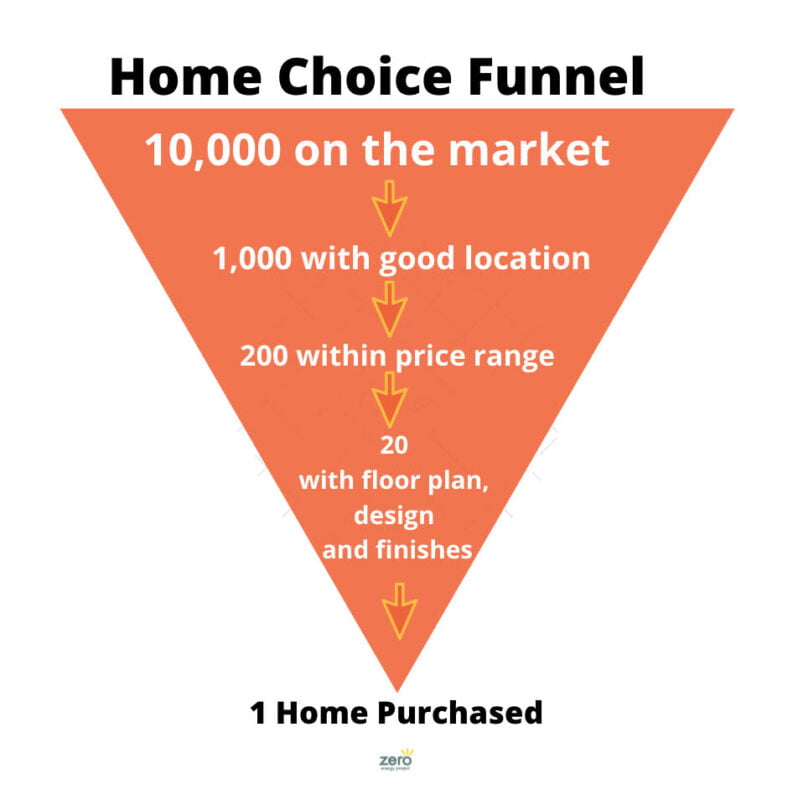
Homes, especially production homes, are usually sold as commodities. This is understandable because in an up market all homes go up in price together and in a down market prices fall together — at these times features and benefits seem less relevant. As a result, traditional home selling often relies on marketing to create “perceived” value, rather than selling the real value of a home. In a commodity market, marketers sell the “sizzle,” rather than the “steak,” focusing on superficial qualities or square footage rather than true value to the buyer.
However, buyers’ behavior makes it clear that they do not view a home purchase the same as buying a commodity, such as a bottle of milk. For buyers, a home purchase is a very complex, personal process involving weeks or months of searching, inspecting, comparing features, and falling in love with homes. When sellers treat homes as commodities, and convince buyers to do the same, they don’t connect to the true values and risks that homes bring to buyers and they fail to address buyers’ deeper needs.
Selling a home as if it were a commodity instead of a unique home, with its own strengths and weaknesses, does not serve the true interests of a buyer or seller. This can be seen in the most widely used metric of value across the industry: cost per square foot. Selling homes by the square foot obscures the superior values of zero energy and zero carbon homes — values that are unrelated to size. These homes have a huge sales advantage in both rising and falling markets. But if buyers, sellers, and brokers see homes only as commodities — basically as all relatively the same except for square footage and countertops — this true value can easily get lost.
Selling the True Value of Zero
With a buyer-oriented sales approach, the value of zero can easily and appropriately become a central focus of this very personal decision-making process. To ensure your zero home is sold for its true value and not as just another commodity, it’s important to focus on and understand what homebuyers need and value and how they make choices. CR Herro, the Vice President for Innovation for Meritage Homes, has years of experience translating the value of energy-efficient green homes to potential buyers. He maintains that effectively selling zero requires understanding what your customer values and how they make choices.
Herro starts with the cardinal rules of real estate sales: understand who your buyer is and what they value for themselves and their family. On average, he maintains, the typical influencer in most home sales is a “36-year-old mom.” She may be financially oriented, design oriented, green oriented, or “other” oriented (looking to brokers for validation). She, like most buyers, is not that interested in the technical features of the home. This means you must translate the positive technical features of a zero energy home into the tangible value and benefits they offer her family.
She usually makes home purchase choices based on the following core needs and values – the first three of which may be considered “commodity needs”:
- Location: near shopping, schools, recreation, or employment
- Floor plan: current residence no longer fits their needs, or they are downsizing or upsizing
- Price: most value at the best price and fits their budget
- Design features: finishes, amenities, and overall look and feel
The Home Choice Funnel
Each of the homebuyer values listed above can become part of a rough conceptual home choice funnel with thousands of homes meeting the first value (location) and very few homes meeting all values.
Most buyers start sorting the MLS to determine the 20 or so homes that meet their commodity needs for location, price, and square footage. And those commodity values often determine the home a buyer finally chooses from among the set that met their needs. While any zero energy home can be built to match standard homes with regard to location, floor plan, design, and price; the key question for buyers then becomes “how do I choose among 20 or so good enough homes?”
According to Herro, 80% of buyers say higher energy efficiency would cause them to buy one home over another and according to JD Power and Associates the top reasons people buy green homes are:
- Cost savings: 94%
- Reduced water waste: 63%
- Less impact on environment: 60%
- Healthier air quality: 53%
- Increased home value: 50%
Therefore, the sustainable values offered by zero homes, when properly presented, can be the critical factor when buyers make their final choice among the 20 or so homes that meet their other criteria.
The Value Zero Brings to Home Choice
The challenge for sellers is to translate the features of a home’s sustainable values into an understanding of how they actually meet buyers’ needs. Sellers need to discover what builds value in the buyers’ eyes to help answer the question: “Why is this the best home for my family?” The sustainable values of a zero home should be framed as a self-serving choice: more comfortable living, better health, more disposable income, a more durable home, lower energy cost, less maintenance, a better investment, a better home, a better value. These are substantive benefits that truly differentiate zero from the competition. They provide buyers with both “more” and “better” — both of which help sell homes.
So sellers have a strong hand when selling the value of zero. To maximize that advantage, partner with a broker with specialized training who understands the technical features of zero and knows how to translate them effectively into benefits that meet buyers’ needs. Make sure your broker knows how to use certifications and ratings to build trust, and be sure she knows how to sell the total cost/value equation of zero.
Sell the Total Cost/Value Equation
Since price is important to homebuyers and more than 90% say cost saving is important in decision making, there is a great opportunity to explain the cost/value equation of zero homes. Sellers must be able to quickly explain it to the “average 36-year-old mom” — or whoever their buyer is — while communicating how it fulfills the buyer’s values and needs. She needs to hear the clear message that zero energy homes are great value and are good investments whose benefits begin the moment she moves in.
Explain what the true monthly cost of ownership of a zero home is compared to a similar standard home and relate it to the monthly amount budgeted for housing expenses. For many, it will mean having more disposable income. Then explain that zero energy homes have a higher resale value. This financial demonstration shows that zero is the best value for buyers across the income spectrum — and especially for low-income buyers. In three sentences, you need to be able to easily convert home cost differences into monthly payments and/or convert monthly savings into net present value. This is the most effective way to sell zero. Even buyers who are focused on design features can easily understand that if their cost of ownership is lower, they can afford more shiny features and trendy amenities.
When buyers are faced with a choice of several homes that meet their needs, after identifying what buyers value, relate their values to the many benefits of a zero home — health, comfort, durability, sustainability. Then effectively explaining that zero homes have a lower total cost will help you close the sale.
By Joe Emerson with thanks to CR Herro of Meritage Homes
C.R. Herro leads Meritage’s Business Innovation Program, which combines design, efficiency, sustainability, and new technologies to establish a new standard in home building that provides better comfort, healthier air, and cost less to own and operate. Many of the concepts in this blog are from two highly recommended CR Herro webinars: Selling and Marketing Green Homes and Zero Energy Homes: Better for Business, Better for Living.